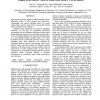Free Online Productivity Tools
i2Speak
i2Symbol
i2OCR
iTex2Img
iWeb2Print
iWeb2Shot
i2Type
iPdf2Split
iPdf2Merge
i2Bopomofo
i2Arabic
i2Style
i2Image
i2PDF
iLatex2Rtf
Sci2ools
136
click to vote
ISBI
2011
IEEE
2011
IEEE
3D elastic registration improves HARDI-derived fiber alignment and automated tract clustering
High angular resolution diffusion imaging (HARDI) allows population studies of fiber integrity and connectivity. Tractography can extract individual fibers. For group studies, fibers must be clustered into recognizable bundles found consistently across subjects. Nonlinear image registration may improve population clustering. To test this, we performed whole-brain tractography with an orientation distribution function based Hough transform method in 20 young adults scanned with 4 Tesla, 105-gradient HARDI. We warped all extracted fibers to a geometrically-centered template using a 3D elastic registration driven by fractional anisotropy maps, to align embedded tracts. Fiber alignment was evaluated by calculating distances among corresponding fibers across subjects. Before and after warping, we performed spectral clustering of the fibers using a k-means method, based on eigenvectors of a fiber similarity matrix. In tests with an overlap metric, non-rigid fiber warping yielded more robust...
Diffusion Imaging | ISBI 2011 | Medical Imaging | Orientation Distribution Function | Similarity Matrix |
| Added | 21 Aug 2011 |
| Updated | 21 Aug 2011 |
| Type | Journal |
| Year | 2011 |
| Where | ISBI |
| Authors | Yan Jin, Yonggang Shi, Neda Jahanshad, Iman Aganj, Guillermo Sapiro, Arthur W. Toga, Paul M. Thompson |
Comments (0)

